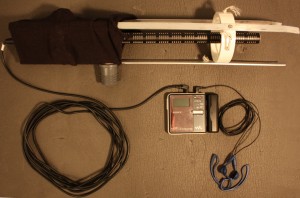Recordist Profile: Paul Hurtado
In response to my last post, Paul Hurtado suggested that I periodically profile recordists and their equipment, as a service to beginners and those shopping for new gear. I loved the idea, and since it was his (and he volunteered), I’m starting with a profile of Paul himself.

According to the bio he sent me, Paul grew up roaming the wild lands around Pueblo, Colorado in search of all things spineless, scaly, slimy or feathered. Since graduating from the University of Southern Colorado, he has been working on his Ph.D. in Applied Mathematics at Cornell University, using mathematical models to study the ecology of infectious diseases.
Here’s the run-down on Paul’s recording gear:
- Microphone: Sennheiser ME67 shotgun microphone with K6 (AA battery) power supply (purchased on eBay for around $250-$300)
- Shockmount & windscreen: homemade. The shockmount for the microphone is fashioned out of PVC pipe, flat aluminum stock, screws and wingnuts from the hardware store, plus shock cord from an outdoor store. The windscreen consists of men’s dress socks. (Editor’s note: homemade shockmounts are really cool and I’d like to talk more about them in a future post.)
- Recorder: Sony Hi-MD minidisc recorder, model MZ-RH910, with the external AA battery pack
- Cable: 3-pin XLR-to-stereo mini cable to connect the mic to the recorder
- Headphones: regular walkman-style
And here is said gear posing for a photo, with the dress-sock windscreen pulled partly off so you can see the microphone and the skeleton of the shockmount:
Paul says:
I originally wanted to get a recording setup to record rarities or interesting breeders (e.g. out of range Chihuahuan Ravens, empids, etc.), but I more often find myself doing other things instead. So far, I use it mostly for personal enjoyment of some of the more common local species and the occasional vocal migrants. It’s a great way to get out and spend time just observing a few individuals for a relatively long period of time. Nest vocalizations, territorial disputes, all these things are amplified enough to reveal a lot of cool behavior you just can’t experience under most circumstances.
I do occasionally chase “target species” I’d like to record (e.g. winter finches are always a treat here in western New York), as well as night-flight calls during migration (although a nice Bill-Evans-style parabolic mic would work way better than a shotgun mic). I’ve used my recording setup to “turn up the volume” for a friend of mine who is somewhat hearing impaired over some frequency ranges, and I even brought it along on a two week field course I helped teach a couple of winters ago down in the Carribean. While recording conditions were horrible during the course, I did get a few “ok” recordings of species that were the subject of student field projects, which they were then able to use in their presentations at the end of the course.
Listen to the sounds of a Vervain Hummingbird (Mellisuga minima) that Paul recorded in Punta Caña, Dominican Republic, in January 2008. The recording is faithful to both the bird and its slightly noisy surroundings:
And here’s another nice recording of Paul’s, of a Hammond’s Flycatcher (Empidonax hammondii) in Pueblo Mountain Park, Pueblo County, Colorado, on 31 May 2006:
You can contact Paul through his website if you have any questions for him about recording!

4 thoughts on “Recordist Profile: Paul Hurtado”
Great idea! I’ve been reading up on recording equipment, but still clueless about how to economically put together a decent system.
Paul had a great suggestion. Thanks, Nathan, for posting this concept. I look forward to additional installments.
I don’t know what my name’s doing here! I clicked up Nathan Pieplow’s blog just now to see if I could find PROOF of the recent Winter Wren split–which is NOT reflected in the November issue of BIRDING in the ABA checklist committee article. (I was surprised) I keep my lifelist on a worldwide cybersite called “bubo” and the people who run it automatically edit all the taxonomy to reflect splits FOR you. Though any Winter Wren split would not affect my list–since I can’t even SEE the thing let alone HEAR it–I’m not interested in that one. However, I AM very interested in the possible upcoming Scrub Jay split as I have seen the California race WELL. The bubo manager has explained how they would handle that. BUT he wants me to tell him where I got my info on the Winter Wren split? Apparently he knows nothing about it! So THAT’S what I’m clicking around on the net trying to find the answer to–since BIRDING mag doesn’t cast any light on it! What is the official SOURCE for the split?
Comments are closed.